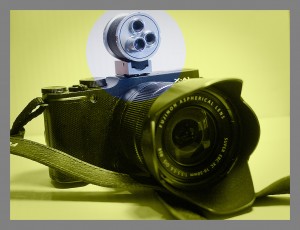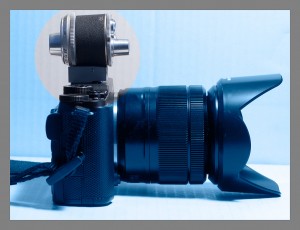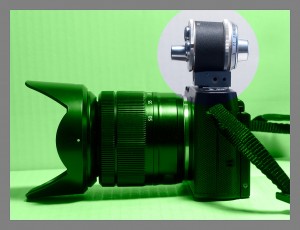As a photographer, I do what I have to do to get the images I need. That includes the possibility of altering the camera or hacking the lens. In most cases it is a simple adaptation of an existing solution.
Over the past few weeks, I have been testing one of the new FujiFilm X series cameras. The model X-A1 is what Fuji describes as an entry-level interchangeable-lens camera. The camera uses a conventional 16-Megapixel APS-C CMOS sensor.
Please read – Disclosure
As an entry level mirrorless, the X-A1 has some pretty impressive features. It has many features that are standard on more expensive models including an interchangeable lens mount, an 3″ articulated LCD screen, ISO 25600, wireless image transfer to mobile devices, a hot shoe, full HD, external command dials, pop up flash and more.
While its features are pretty impressive for a relatively inexpensive camera it lacks an EVF (electronic viewfinder). Having an articulating LCD view-screen on the back is a nice feature, but it is the only way of composing your shots. It seems that a simple viewfinder would greatly facilitate the use of this and similar cameras.
I am guessing that not having a viewfinder is one of the ways that allow the camera to be built at a reduced cost. I am also guessing that the demographic for this camera is pretty much accustomed to using an LCD view-screen to frame and shoot.
While many people have become used to shooting using only the LCD view-screen, there are some like myself that like to frame and shoot by looking through an actual viewfinder, which among other things, just seems more professional.
Personally, I find it less intuitive and somewhat awkward to simply use the view-screen as a way to capture spontaneous images. In situations like street photography, I am interested is looking directly at the subject. With a good viewfinder, I cannot only see my subject; I can see what else is coming into the frame. That means I can be ready for what is about to happen. I can plan ahead.
In the days of rangefinder cameras, most good cameras came with a viewfinder, a combination view/range/finder, or optional viewfinders for specific lenses. This allowed the photographer to quickly frame the subject and fire the camera while looking directly at the subject. This is very different to watching an electronic view-screen on the back of a camera held at arms length.
Unfortunately, most manufacturers do not make separate viewfinders for their digital mirrorless cameras.
However, all is not lost. There are plenty of optional viewfinders that are available in the vintage marketplace that can be very helpful for at least a portion of your cameras zoom range. These vintage viewfinders come in different flavors that can be adapted to your mirrorless camera via the hot-shoe.
Keep in mind, that the use of these devices doesn’t allow you to use all of the zoom points on your lens. For at least a portion of your shots, you will be restricted to using only those zoom points that the viewfinder allows. Anything else can be accomplished using your LCD monitor. What the viewfinder does is mimic the views of the prime lenses that were used on early cameras. I like to call them “Prime” lens settings.
Why would you want to do that?
Some of the better ones were built with multiple view lenses, which represent what was a standard selection of focal lengths such as a 50-mm standard lens, 100-mm telephoto, and 35-mm wide angle that were common on full frame 35-mm rangefinder film cameras. There are a few finders that come with rotating turret lenses and some that will actually zoom between two extremes depending on the make and model. There are others that are specific to a single focal length.
Some of the best ones were produced for Leica, Argus, Canon, Nikon and Zeiss. But there were others as well. These viewfinders can be purchased from eBay vendors at a relatively small cost compared to an EVF. The one shown here is an Argus.
While auxiliary viewfinders are not as convenient as a good EVF, they can be very useful. In some cases, they can save a lot of time during the shooting session. With a digital camera, autofocus means that all you usually need to do is frame the subject. Therefore, the viewfinder is simply used for fast framing.
More importantly, the use of a viewfinder held to your eye allows you to hold the camera a lot steadier than when shooting with outstretched arms.
To use these oldies, you will need to set the zoom point on the lens to match the viewfinder. After setting the zoom to match the optical viewfinder, I usually make a note of the zoom position, or mark it with a tiny piece of tape. On the FujiFilm A-X1 for instance, the sensor is an APS-C, which means it has a surface area that is smaller than the full frame of a 35-mm camera, which the viewfinder was originally made for. Basically, it means that the focal lengths indicated on the viewfinder are magnified by a factor of 1.5. All this really means is that the markings on the viewfinder will represent longer focal lengths by a factor of approximately 1.5. As an example, the 50-mm marking when mounted to the X-A1 will become slightly telephoto from the “normal view” that it represented on the film camera.
There are a few things worth noting. Because these external viewfinders sit on top of the camera, they offer a slightly offset view of the subject. They do not allow you to see exactly what the camera sees. As such, there is a slight difference in framing from what the camera lens is actually seeing. This offset is what we call parallax. It is very easy to compensate by simply moving the camera slightly upward as the subject gets closer to the camera and moving it slightly down at a distance. I set my finders at the distance that corresponds to my most shot subjects and simply move the camera slightly up and down for close and far. It really is not a big problem.
That small inconvenience is nothing considering the advantages of using a finder to see your subject.
Personally, I like to use them for shooting portraits and certain types of landscapes. I also think they look kinda cool and somewhat retro perched on top of these kinds of cameras.
I have used auxiliary viewfinders on a number of other mirrorless cameras. The FujiFilm X-A1 is nicely appointed, and as I mentioned above, it is a pretty capable shooter for the price. A point to mention, is that the popup flash will still pop up with an auxiliary viewfinder mounted in the flash shoe.
For me, the addition of an auxiliary viewfinder makes a mirrorless camera such as this Fuji just that much better. If I were to keep the X-A1, I would definitely mount one to facilitate the kinds of shooting I like to do.
I cover many photographic topics and techniques in my book. – Great Photography Gift Idea for any Photographer.
Please have a look at some of my other posts here.
NOTICE of Copyright: THIS POSTING AS WELL AS ALL PHOTOGRAPHS, GALLERY IMAGES, AND ILLUSTRATIONS ARE COPYRIGHT © JOHN NEEL AND ARE NOT TO BE USED FOR ANY PURPOSE WITHOUT WRITTEN CONSENT FROM THE WRITER, THE PHOTOGRAPHER AND/OR lensgarden.com. THE IDEAS EXPRESSED ARE THE PROPERTY OF THE PHOTOGRAPHER AND THE AUTHOR.





